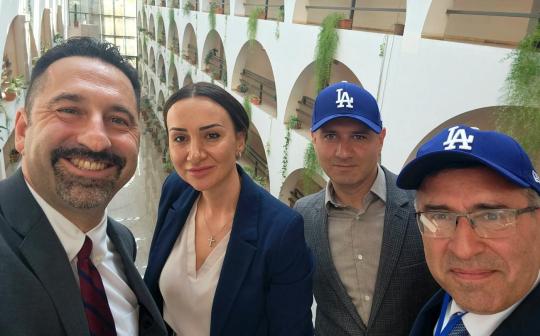How a spying drone led Texas tech chief to an emerging tech epiphany

“I’m sitting there working away and all of a sudden I lean back and look up and there is this drone hovering outside my window,” Todd Kimbriel told an audience at the National Association of State Chief Information Officers midyear conference on Tuesday.
Kimbriel said he looked up from his monitor only to discover the camera of a drone staring right back at him.
“All I was thinking is ‘Is that what I think it is?!’ and yes, sure enough, it starts to move around and I watched as it flew around the capitol building.”
The Texas state chief information officer was sharing a story as part of a small group discussion with state IT leaders that stressed a broader message that, accept it or not, a new world of drones, autonomous cars, artificial intelligence and the Internet of Things is here and state leaders must adapt their strategies and tools to keep pace.
Kimbriel reported the activity to security and pulled up his smartphone to film the drone’s operator standing on a nearby hotel rooftop. Security handled the incident in minutes, the CIO said, but the experience impressed a sense of urgency, something he said he still feels today as technologies progress and expectations on government increase.
“If you can’t evolve your thinking of how you’re solving problems, then you’re going to get behind the curve and that’s death, really,” Kimbriel said. “You’re not going to be able to deliver an acceptable level of services to your citizens.”
During the session, the speakers said the regulations for drones are in flux both at the state and federal level, adding an additional layer of complexity. Kimbriel and Robinson agreed the roles in governing and deploying new technologies is complicated by the lack of universal standards. It’s important, for example, that autonomous cars can travel between states without regulations mandating different mechanical parts or adjustments to cross state lines, Kimbriel said.
The solution to uncertainty, he said, is iterating quickly.
“You’re better off if you ‘fail fast,’” Kimbriel said. “If a solution is going to cost you $10 million in taxpayer dollars, you’re better off paying $500,000 to find out you can’t do something. That’s an investment that saves your state $9.5 million dollars.”
Not everything will happen within state government, Kimbriel said — universities and community organizations will also play an important role with technologies like the Internet of Things. States are better suited as a supporting resource for guidance and tools, he said, rather than a role of micromanaging from a distance.
“A lot of that IoT technology is about that frontline engagement with citizens. It’s the physical interaction with issues like reporting pot holes and locating where things are in cities.” Kimbriel said.
“It’s more doable for us, and at least immediately, to focus on helping cities and counties in their approach to how they’re able to adopt IoT technology in a rational and safe fashion and not forcing them to do that. You can’t do that anyway in Texas, because everyone carries a gun,” he quipped.
In the discussion, the group acknowledged many of today’s innovations still need to mature before states can depend on them to provide government services. Yet a few are making headway.
Police are already putting Aerial drones in operation for tactical surveillance. There are occasional uses of office assistants like Amazon’s Echo that Kimbriel predicts will gain momentum in the coming years. And with smart cities like Dubai demanding that blockchain become the standard technology to manage its contracts and financials, it’s only a matter of time before other cities start testing the technology or follow suit.
“Personally I will say it’s extremely disruptive, and it will have the same impact in five years as virtualization had on technology in 2000 to 2002, which lead to today’s cloud services,” Kimbriel said.
While there’s a race at the state level for who can bring emerging technologies like autonomous vehicles to consumers quickest, Kimbriel said his sources place consumer-grade autonomous vehicles at about 20 years out. But as with any new technology, he said, timelines like these aren’t a pass for inaction on behalf of leaders. Collaboration with federal leadership, state agencies, and industry leaders will be a requisite to cement policies that can encourage adoption self-driving vehicles, he said.
“It’s not the Big Bang strategy of solving everything at once, but I think it’s all about having an incremental process,” Kimbriel said.






